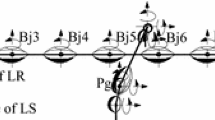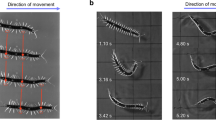Abstract
In order to explore the neural mechanism underlying salamander terrestrial turning, an improved biomechanical model is proposed by modifying the forelimb structure of the existing biomechanical model. Based on the proposed improved biomechanical model, a new spinal locomotor network model is constructed which contains the interneuron networks and motoneuron pool. Control methods are also developed for the new model which increase its transient response speed, control the initial swing order of the forelimbs, and generate different walking turning gait and turning on the spot (turning without moving forward). The simulation results show that the biomechanical model controlled by the new spinal locomotor network model can generate different walking turning and turning on the spot, and can control posture and the initial swing order of the forelimbs. Moreover, the transient response speed of the proposed model is very rapid. This paper thus provides a useful tool for exploring the operational mechanism of the spinal circuitry of the salamander. In addition, the research results presented here may inspire the construction of artificial spinal control networks for bionic robots.









Similar content being viewed by others
References
Ampatzis K, Song J, Ausborn J, Manira AEI (2013) Pattern of innervation and recruitment of different classes of motoneurons in adult zebrafish. J Neurosci 33(26):10875–10886
Ampatzis K, Song J, Ausborn J, Manira AEI (2014) Separate microcircuit modules of distinct V2a interneurons and motoneurons control the speed of locomotion. Neuron 83(4):934–943
Ashley-Ross MA (1994) Hindlimb kinematics during terrestrial locomotion in a salamander (Dicamptodon tenebrosus). J Exp Biol 193(1):255–283
Bem T, Cagelguen J-M, Ekeberg Ö, Grillner S (2003) From swimming to walking: a single basic network for two different behaviors. Biol Cybern 88(2):79–90
Bicanski A, Ryczko D, Cabelguen J-M, Ijspeert AJ (2013a) From lamprey to salamander: an exploratory modeling study on the architecture of the spinal locomotor networks in the salamander. Biol Cybern 107(5):565–587
Bicanski A, Ryczko D, Knuesel J, Harischandra N et al (2013b) Decoding the mechanisms of gait generation in salamanders by combining neurobiology, modeling and robotics. Biol Cybern 107(5):545–564
Bizzi E, Cheung V, d’Avella A et al (2008) Combining modules for movements. Brain Res Rev 57(1):125–133
Bolt JR (1969) Lissamphibians origins: possible protolissamphibian from the Lower Permian of Oklahoma. Science 166(3907):888–891
Bolt JR (1977) Dissorophoid relationships and ontogeny and the origin of Lissamphibia. J. Paleont 51(2):235–249
Cabelguen J-M, Ijspeert A, Lamarque S, Ryczko D (2010) Axial dynamics during locomotion in vertebrates: lesson from the salamander. Prog Brain Res 187:149–162
Chevallier S, Ijspeert AJ, Ryczko D, Nagy F et al (2008) Organization of the spinal central pattern generators for locomotion in the salamander: biology and modeling. Brain Res Rev 57(1):147–161
d’Avella A, Saltiel P, Bizzi E (2003) Combinations of muscle synergies in the construction of a natural motor behavior. Nat Neurosci 6(3):300–308
Degallier S, Ijspeert A (2010) Modeling discrete and rhythmic movements through motor primitives: a review. Biol Cybern 103(4):319–338
Ekeberg Ö (1993) A combined neuronal and mechanical model of fish swimming. Biol Cybern 69(5):363–374
Endo T, Kiehn O (2008) Asymmetric operation of the locomotor central pattern generator in the neonatal mouse spinal cord. J Neurophysiol 100:3043–3054
Feldman AG (1986) Once more on the equilibrium-point hypothesis (λ model) for motor control. J Mot Behav 18(1):17–54
Harischandra N, Cabelguen J-M, Ekeberg Ö (2010) A 3D musculo-mechanical model of the salamander for the study of different gaits and modes of locomotion. Front. Neurorobot 4:1–10
Harischandra N, Knuesel J, Kozlov A, Bicanski A et al (2011) Sensory feedback plays a significant role in generating walking gait and in gait transition in salamanders: a simulation study. Front. Neurorobot 5:1–13
Hogan N, Sternad D (2007) On rhythmic and discrete movements: reflections, definitions and implications for motor control. Exp Brain Res 181(1):13–30
Ijspeert AJ (2000) A 3-D biomechanical model of the salamander. Lect Notes Comput Sci 1834:225–234
Ijspeert AJ (2001) A connectionist central pattern generator for the aquatic and terrestrial gaits of a simulated salamander. Biol Cybern 84(5):331–348
Ijspeert AJ (2008) Central pattern generators for locomotion control in animals and robots: a review. Neural Netw 21(4):642–653
Ijspeert AJ, Crespi A, Ryczko D, Cabelguen J-M (2007) From swimming to walking with a salamander robot driven by a spinal cord model. Science 315(5817):1416–1420
Johnson MD, Heckman CJ (2014) Gain control mechanisms in spinal motoneurons. Front Neural Circuits 8(81):1–7
Johnson MD, Hyngstrom AS, Manuel M, Heckman CJ (2012) Push–pull control of motor output. J Neurosci 32(13):4592–4599
Kiehn O (2016) Decoding the organization of spinal circuits that control locomotion. Nat Rev Neurosci 17(4):224–238
Knüsel J, Bicanski A, Ryczko D, Cabelguen J-M et al (2013) A salamander’s flexible spinal network for locomotion, modeled at two levels of abstraction. Integr Comp Biol 53(2):1–14
Latash ML (2010) Motor synergies and the equilibrium-point hypothesis. Mot Control 14(3):294–322
Liu Q, Wang JZ (2018) Modeling and analysis of a new locomotion control neural network. Biol Cybern 112(4):345–356
Liu Q, Yang HZ, Zhang JX, Wang JZ (2018) A new model of the spinal locomotor networks of a salamander and its properties. Biol Cybern 112(4):369–385
Markin SN, Klishko AN, Shevtsova NA, Lemay NA (2010) Afferent control of locomotor CPG: insights from a simple neuromechanical model. Ann N Y Acad Sci 1198:21–34
Matsui K, Hishii Y, Maegaki K, Yamashita Y (2014) Equilibrium-point control of human elbow-joint movement under isometric environment by using multichannel functional electrical stimulation. Front Neurosci 8(164):1–9
McLean D, Fan J, Higasshijima S, Hale ME, Fetcho JR (2007) A topographic map of recruitment in spinal cord. Nature 446(3):71–75
McLean DL, Masino MA, Koh IYY, Lindquist WB, Fetcho JR (2008) Continuous shifts in the active set of spinal interneurons during changes in locomotor speed. Nat Neurosci 11(12):1419–1429
Mussa-Ivaldi FA, Giszter SF, Bizzi E (1994) Linear combinations of primitives in vertebrate motor control. Proc Natl Acad Sci 91(16):7534–7538
Ryczko D, Knüsel J, Crespi A, Lamarque S, Mathou A, Ijspeert AJ, Cabelguen JM (2015) Flexibility of the axial central pattern generator network for locomotion in the salamander. J Neurophysiol 113:1921–1940
Talpalar AE, Endo T, Löw P, Kiehn O (2011) Identification of minimal neuronal networks involved in flexor-extensor alternation in the mammalian spinal cord. Neuron 71(6):1071–1084
Acknowledgments
This work is supported in part by the National Natural Science Foundation of China under grants 61105110 and 11573011, the Natural Science Foundation of the Jiangsu Higher Education Institutions of China under grant 14KJB510004, the Lianyungang “Petrel Project,” the Lianyungang “521” Project, and the Six Talent Peaks Project in Jiangsu Province.
Author information
Authors and Affiliations
Corresponding author
Additional information
Communicated by Benjamin Lindner.
Publisher's Note
Springer Nature remains neutral with regard to jurisdictional claims in published maps and institutional affiliations.
Electronic supplementary material
Below is the link to the electronic supplementary material.
Appendices
Appendix 1: Calculation of turning control input for turning gait IV
When the biomechanical model turns left, the turning control inputs applied to the elbow joint and leg-raising oscillators for generating turning gait IV can be calculated by:
where \( k_{ 3} \) is the control gain of turning gait IV, \( F_{l} \) is the contact force between the left forelimb and the ground, \( F_{r} \) is the contact force between the right forelimb and the ground, and \( F_{T} \) is the contact force threshold between the forelimb and the ground.
When the biomechanical model turns right, the turning control inputs applied to the elbow joint and leg-raising oscillators for generating turning gait IV can be calculated by:
Appendix 2: Calculation of turning control input for side-stepping applying control signals to the motoneuron pool
When the biomechanical model turns left, the turning control signals applied to the forelimb motoneuron pool for the side-stepping can be calculated by:
where \( k_{ 3} \) is the control gain of the side-stepping applying the turning control signals to the motoneuron pool.
When the biomechanical model turns right, the turning control signals applied to the forelimb motoneuron pool for the side-stepping can be calculated by:
Rights and permissions
About this article
Cite this article
Liu, Q., Zhang, Y., Wang, J. et al. Modeling of the neural mechanism underlying the terrestrial turning of the salamander. Biol Cybern 114, 317–336 (2020). https://doi.org/10.1007/s00422-020-00821-1
Received:
Accepted:
Published:
Issue Date:
DOI: https://doi.org/10.1007/s00422-020-00821-1




